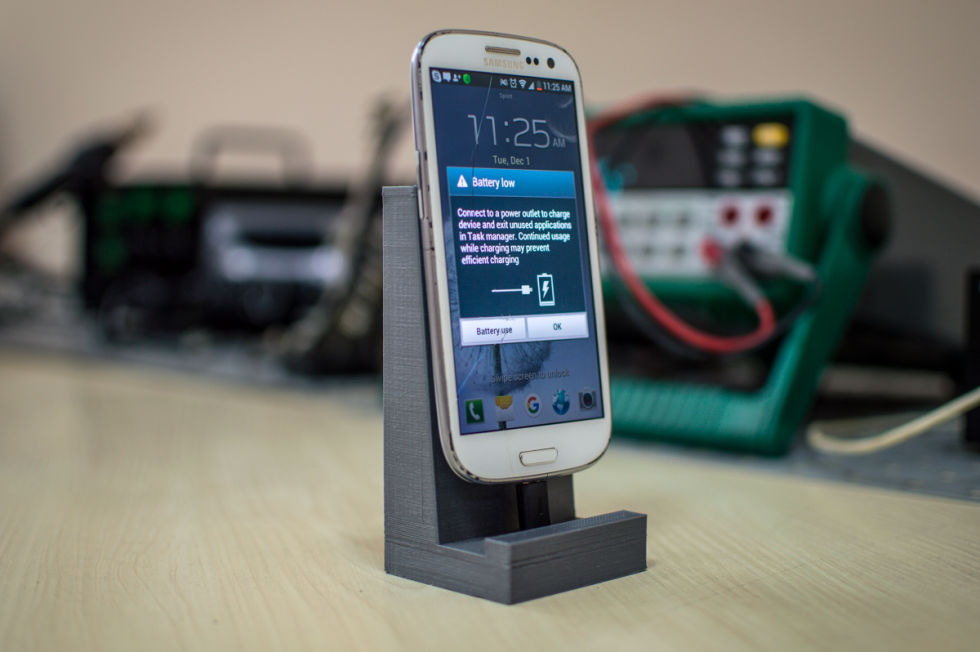The wireless power delivery tech uses the same principle as a crystal radio.
Quick test
XE’s team demonstrated an early prototype of its wireless charging tech to Ars Technica at the XE office in Kyiv, Ukraine. The current version isn’t as compact as it will (hopefully) become; the antenna and a buffer battery sit in a 3D-printed cradle, while the transmitter is contained in a large black box. The transmitter was turned on for a while and then turned off again once the phone began to charge. (It can take up to 20 seconds for the charging to start after the transmitter is powered. That’s the time needed for the buffer battery to build up a head of steam.)  An animated GIF showing the phone going from discharging, to recharging, and then back to discharging again. Although XE wouldn’t let us take pictures of what’s inside the cradle, it seemed to only contain an antenna, a buffer battery, and a circuit board with a bunch of wires. The whole thing at least appears to be working as described, with power being wirelessly transmitted to the smartphone. But how does it do so?
An animated GIF showing the phone going from discharging, to recharging, and then back to discharging again. Although XE wouldn’t let us take pictures of what’s inside the cradle, it seemed to only contain an antenna, a buffer battery, and a circuit board with a bunch of wires. The whole thing at least appears to be working as described, with power being wirelessly transmitted to the smartphone. But how does it do so?
How it works
The project began as a curious thought in the brain of the startup’s founder, Ivan Chuba: could a smartphone be powered like an old crystal radio? “About 20 years ago, when I only got interested in radio electronics, crystal radios were quite popular,” Chuba told Ars. “So I recalled that and wondered if it would be possible to apply the same principle to smartphone charging.” The idea of a crystal radio is simple: with just a coil of copper wire, antenna, capacitor, crystal detector, and high-impedance earphones—and no additional power—you can listen to some radio stations, though the sound level is weak. What XE claims to have done is build an efficient combination of a transmitter and receiver so that the power passed along could be used to charge the buffer battery. XE’s team of eight people based in Ukraine, Poland, and the UK has spent more than a year looking for the most efficient configuration for such a system. “The main breakthrough we’ve achieved is the antenna,” Chuba said. “On our working frequency, which is in the SW band, you’d normally need a large antenna to receive the signal and pass it on to the converter. We have built an antenna capable of doing this that can be housed in an iPhone 6/6S case.”
Chuba refused to name the exact frequency the device is working on, claiming it was an important trade secret. He only mentioned that it’s “under 100 MHz.” “We spent a long time checking all the frequencies in this band to find the best one for our purposes,” he said. Before working on XE, Chuba was the CTO at another Ukrainian startup, iBlazr, which created an external flash for smartphones. (The product is currently sold in the Apple Store.) A few other companies are working on different kinds of remote wireless charging but none of them seems to be doing quite the same thing as XE. Energous and Cota work along the same lines but run on the same frequencies as Wi-Fi and Bluetooth appliances, between 2.4 GHz and 5.8 GHz. Another rival, uBeam, is building a solution that uses ultrasound waves.Production plans
Addressing the obvious safety concerns, Chuba said that the transmitter’s nominal rating power is 2.5W and its maximum output is 5W, which is safe for people and animals. The team is currently working on a new prototype that it can take to the SVOD Europe conference in Dublin in January. From there, the prototype will be sent to a certification center in the UK in order to receive the necessary documents to start mass production. While most consumer electronic devices and accessories are produced in China, XE plans to manufacture its gadgets in Poland. “The technology is quite complex and needs thorough fine-tuning, which is easier to do in Poland where we have a team member,” Chuba said. “Moreover, in China there’s a possibility that the technology would be quickly copied.” While the final price will be determined in early 2016, Chuba said the goal is to bring it under £140/$200 for the transmitter and one charging case. One transmitter is enough to charge up to four devices simultaneously, so customers will be able to buy more cases for other gadgets in their households. Initially, XE will offer cases for iPhone 6 and 6S, but in the future the startup plans to widen the range. The idea is to license the technology to established case vendors. “We’re going to license it as much as possible,” Chuba said. “It makes no sense for us to try to go after the whole market. Maybe some of the phone vendors will want to include the charging element in their devices.” In the future, XE plans to create chargers for other consumer electronic devices, from smartwatches to laptops. The latter should be relatively easy to work with, as the size of the charging element and antenna there isn’t as limited as in smartphones.


